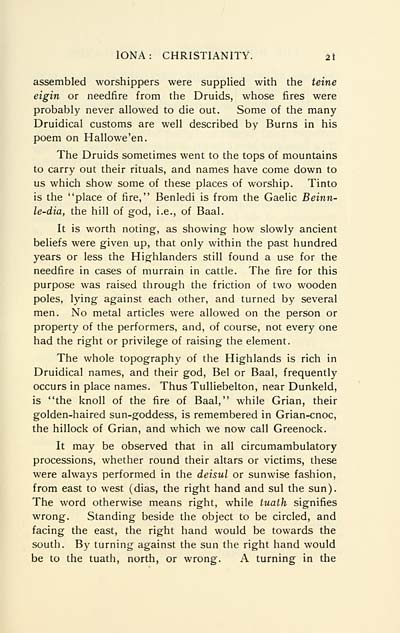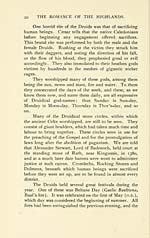Download files
Complete book:
Individual page:
Thumbnail gallery: Grid view | List view

lONA: CHRISTIANITY. 2i
assembled worshippers were supplied with the teine
eigin or needfire from the Druids, whose fires were
probably never allowed to die out. Some of the many
Druidical customs are well described by Burns in his
poem on Hallowe'en.
The Druids sometimes went to the tops of mountains
to carry out their rituals, and names have come down to
us which show some of these places of worship. Tinto
is the "place of fire," Benledi is from the Gaelic Beinn-
le-dia, the hill of god, i.e., of Baal.
It is worth noting, as showing how slowly ancient
beliefs were given up, that only within the past hundred
years or less the Highlanders still found a use for the
needfire in cases of murrain in cattle. The fire for this
purpose was raised through the friction of two wooden
poles, lying against each other, and turned by several
men. No metal articles were allowed on the person or
property of the performers, and, of course, not every one
had the right or privilege of raising the element.
The whole topography of the Highlands is rich in
Druidical names, and their god, Bel or Baal, frequently
occurs in place names. Thus Tulliebelton, near Dunkeld,
is "the knoll of the fire of Baal," while Grian, their
golden-haired sun-goddess, is remembered in Grian-cnoc,
the hillock of Grian, and which we now call Greenock.
It may be observed that in all circumambulatory
processions, whether round their altars or victims, these
were always performed in the deisul or sunwise fashion,
from east to west (dias, the right hand and sul the sun).
The word otherwise means right, while tuath signifies
wrong. Standing beside the object to be circled, and
facing the east, the right hand would be towards the
south. By turning against the sun the right hand would
be to the tuath, north, or wrong. A turning in the
assembled worshippers were supplied with the teine
eigin or needfire from the Druids, whose fires were
probably never allowed to die out. Some of the many
Druidical customs are well described by Burns in his
poem on Hallowe'en.
The Druids sometimes went to the tops of mountains
to carry out their rituals, and names have come down to
us which show some of these places of worship. Tinto
is the "place of fire," Benledi is from the Gaelic Beinn-
le-dia, the hill of god, i.e., of Baal.
It is worth noting, as showing how slowly ancient
beliefs were given up, that only within the past hundred
years or less the Highlanders still found a use for the
needfire in cases of murrain in cattle. The fire for this
purpose was raised through the friction of two wooden
poles, lying against each other, and turned by several
men. No metal articles were allowed on the person or
property of the performers, and, of course, not every one
had the right or privilege of raising the element.
The whole topography of the Highlands is rich in
Druidical names, and their god, Bel or Baal, frequently
occurs in place names. Thus Tulliebelton, near Dunkeld,
is "the knoll of the fire of Baal," while Grian, their
golden-haired sun-goddess, is remembered in Grian-cnoc,
the hillock of Grian, and which we now call Greenock.
It may be observed that in all circumambulatory
processions, whether round their altars or victims, these
were always performed in the deisul or sunwise fashion,
from east to west (dias, the right hand and sul the sun).
The word otherwise means right, while tuath signifies
wrong. Standing beside the object to be circled, and
facing the east, the right hand would be towards the
south. By turning against the sun the right hand would
be to the tuath, north, or wrong. A turning in the
Set display mode to: Large image | Transcription
Images and transcriptions on this page, including medium image downloads, may be used under the Creative Commons Attribution 4.0 International Licence unless otherwise stated. ![]()
| Early Gaelic Book Collections > Ossian Collection > Romance of the Highlands > (47) |
|---|
| Permanent URL | https://digital.nls.uk/81816189 |
|---|
| Description | Selected books from the Ossian Collection of 327 volumes, originally assembled by J. Norman Methven of Perth. Different editions and translations of James MacPherson's epic poem 'Ossian', some with a map of the 'Kingdom of Connor'. Also secondary material relating to Ossianic poetry and the Ossian controversy. |
|---|
| Description | Selected items from five 'Special and Named Printed Collections'. Includes books in Gaelic and other Celtic languages, works about the Gaels, their languages, literature, culture and history. |
|---|

